Srivalli Rekha (Semi Hiatus)'s Blog, page 30
April 15, 2024
N for Nahusha - Mahabharata Mashup
Namaskar,
Family trees are taken to a new level inMahabharata. There are so many characters, so many relations, diversions,additions, and whatnot that it can be overwhelming for most of us. Anyhoo, wewon’t be dealing with all that now.
Nahusha is an ancestor of the Puru/ Kuru dynasty andthe forefather of the Pandavas. He was called a rajarishi (a king who is alsoa rishi) and known for his goodness until power corrupted him and resulted in adownfall.

In Aranyaka Parva, Bhima went to explore the forestand came across a massive snake curled over a cave’s mouth. The snake said toBhima that it would eat him. Bhima, despite all his strength, couldn’t freehimself. The snake said he was Nahusha, an ancestor cursed to live like a snakeuntil someone from his future generations would answer his questionssatisfactorily and break the curse.
Well, long story short, Yudhistira wentlooking for Bhima and answered all the questions, freeing Nahusha and helping himregain his position in the astral realm.
But why was Nahusha cursed, and by whom?
Eons ago, Indra lost his right to the throne when hegot a pious Vritra slaughtered. He had to perform penance to atone for hissins. Since heaven needed a ruler, the celestial deities went to Nahusha andasked him to take the throne temporarily. He objected at first but agreed.However, his good nature began to get corrupted by the power of his position.It made him arrogant and invincible.
Nahusha demanded Indra’s wife, Sachi Devi, marry himsince he was now Indra. He was willing to use force if necessary. Sachi Devitook refuge with Brahma, who assured her she would not be married to anyone shedisliked and Indra would be her husband. However, they needed her help to removeNahusha from the throne. She agreed.

Sachi Devi told Nahusha she would marry him butwanted to see him as the lord of the world and ride a palanquin carried by theseven celestial rishis. Nahusha was delighted and ordered the same. He was soheady with power that he kicked Rishi Agastya, urging them to love faster.
Rishi Agastya was furious and cursed Nahusha to fall from heaven and become aserpent. Nahusha had been in the same serpent form for centuries, waiting for Bhima andYuhistira to come his way and free him from the curse. He shared his learningwith the Pandavas brothers, urging them not to commit similar mistakes and letarrogance and power control them.
Fun Fact: Snakes are a recurring theme in Mahabharata and appear in various forms. Vasuki, Takshaka, Nahusha, and Asvasena (Takshaka's son) are some examples.
Do you know the names of Kardu's Naga sons? .
I’m participating in #BlogchatterA2Z.
The AI images are made on Bing.
April 14, 2024
M for Matali, The Charioteer of Indra - Mahabharata Mashup
Namaste,
Charioteers have a special role in Mahabharata.Krishna was Arjuna’s charioteer in the Kurukshetra War. Daruka was Krishna’strusted charioteer. Visoka was Bhima’s charioteer. King Shalya of Madra becamea charioteer for Karna on day 17 of the war.
Matali was the charioteer for Indra (the King ofHeaven). He was first mentioned in Aranyaka Parva when Indra met Arjuna on theHimalayan peak after performing tapasya. When it was time, he said Matali wouldarrive to take Arjuna to heaven for training in the use of celestial weapons.The chariot was pulled by ten thousand horses and had magical properties. Itwas invisible to most and carried the Vaijayanthi flag on a goldenflagstaff.

Matali appeared again when Arjuna was gifted thecelestial weapons and was sent to kill the Nivatakavacas hidden in the ocean’swomb. He gave timely advice to Arjuna in defeating the daityas (demons/ anti-gods).
Next in Udogya Parva, Rishi Kanva narrated the storyof how Matali found a groom for his daughter with Narada’s help.
The story goes that Matali wanted a suitable husbandfor his lovely daughter Gunakesi. He discussed the issue with his wife,Sudharma, and decided to go to the Naga world to look for a groom. He metNarada en route the next day. Narada offered help and accompanied Matali tomany kingdoms, singing praises and revealing the flaws of the prospectivegrooms. They went to Patala (underworld) and checked out the various kingdomsin it - Hiranyapura, Rasatala, and Bhogavati.
Finally, Matali saw a young and handsome Naga princeand wanted to know his details. Narada said it was Sumukha from the Airavatafamily, Aryaka’s grandson and Cikura’s son. They met Aryaka with the proposal,but he refused, saying Garuda had killed Cikura and promised to kill Sumukhasoon. How could he knowingly get the boy married in such instances?
Narada and Matali convinced Aryaka that they wouldensure Sumukha’s safety. Aryaka agreed to the wedding. Next, Matali and Naradawent to Indra with their problem. Indra was pleased to know that they found asuitable groom for young Gunakesi. He happily granted a long life toSumukha.

Garuda got to know of this and was upset as itnullified his vow to kill Sumukha. He considered Indra a friend and dislikedthis decision. Garuda was boastful of his powers when Maha Vishnu intervenedand placed an arm on his shoulder. The majestic Garuda couldn’t bear the weightof Vishnu’s arm and fell unconscious. He regained consciousness a while laterand asked for forgiveness for being arrogant. Vishnu then flicked Sumukha ontoGaruda’s chest and made them befriend each other.
Thus, Matali got his daughter married to a Naga ashe and his wife planned and also made sure his son-in-law had a long life. Ofcourse, Mahamuni Narada had a vital role in this story.
Matali doesn't have much role but manages to make his presence felt.
I’m participating in #BlogchatterA2Z.
The AI images are made on Bing.
April 13, 2024
Bloodshed on the Boards by Judy Leigh - Book Review
Series: A Morwenna Mutton Mystery #2
Publication Date: 11th April 2024
Genre: Small Town Cozy Mystery
3.2 Stars
One Liner: A nice read
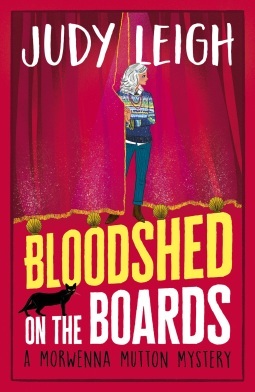
The Spriggan Travelling Theatre Company arrived in Seal Bay and is all set to perform the Cornish version of King Arthur. Morwenna and the townsfolk are excited.
The stage is set, and the play is in progress when the actor and director, Daniel Kitto, falls dead for real. Turns out that Daniel has many enemies, and his death could benefit many actors from the theatre company.
Though the police have closed the case, calling it a natural death, Morwenna is determined to find the truth. Soon, her investigation takes her on dangerous paths. Can the sexagenarian librarian and amateur sleuth expose the killer without getting killed?
The story comes in Morwenna’s third-person POV.
My Thoughts:The book starts a few months after the end of the previous one. It should work as a standalone, though there are a few references to that case. Nothing that connects with this mystery, though.
There are many characters to track (villagers and the actors), so it might be better to read book #1 first (not that I remember all of them, but I could get into the flow without difficulty).
The pacing is slow, which I expected. However, there is some sort of plot development to keep the story going. We also have Morwenna’s personal track to follow, so the story doesn’t drag.
The mystery is well done and keeps the reader guessing. There are a couple of red herrings and twists, though everything falls into place by the end.
I enjoyed the family dynamics in the first book. This had similar elements, though I didn’t find it as endearing as before. It could be due to some decisions Morwenna takes, which seem odd. Don’t want to reveal any spoilers, but the general vibe I get from her is of someone who is bored despite her active lifestyle and wants to latch on to this mystery. She seemed a bit too possessive about the case (this is MY case vibes).
PC Jane doesn’t get much space, which is another issue for me. I like her stability and determination. The police have almost no role until the end. While this is not uncommon in the genre, there are enough instances for the police to be involved, and Morwenna can still solve the case.
I love how the FMC is a 60+ woman who bikes her way through the hills and Seal Bay roads. However, I don’t particularly like her indecisiveness. Yeah, it is necessary for the subplot. Yet, I can’t help but say that if she allotted 10% of her sleuthing time to truly explore her feelings, things would be a lot better. This is a personal preference. I’m not a fan of indecisive characters.
Elowen is a treat to read. She is 6+ in this book and knows her mind (learn from her!). The kid wants a dog, a Labrador, and will take every opportunity to ask for one. Such an adorable sweetheart!
Lamorna, Tamsin, and the side characters are well done. Some are not rounded, but that’s fine. They do the job. We still have the ghost subplot as strong as ever. I will read book three if it deals with the ghost. I hope it does since we have a lead here.
To summarize, Bloodshed on the Boards is a nice mystery with interesting characters and a great setting. The story has its merits, though I have the same feeling as I did with book one.
Thank you, NetGalley and Boldwood Books, for eARC.
#NetGalley #BloodshedOnTheBoards
April 12, 2024
L for Love Stories in Mahabharata - Mahabharata Mashup
Namaskar!
Well, the Mahabharata has some love storieswith varying themes. I’ll do my best to keep it as brief as possible. (This is still a long post!)
In Adi Parva, we have two stories –
Rishi Ruru and Pramadvara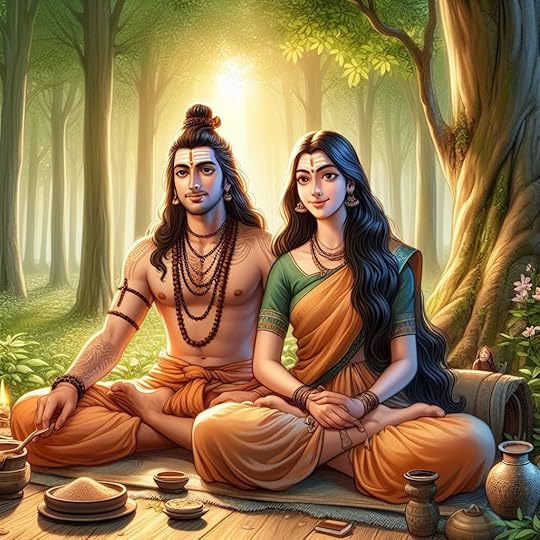 Rishi Ruru is the grandson of Rishi Chyavana.Pramadvara is Menaka and Visvavasu’s (Gandharva) daughter, abandoned by themother after birth. Rishi Sthulakesa found the baby and named her Pramadvara.He brought her up as his daughter.
Rishi Ruru is the grandson of Rishi Chyavana.Pramadvara is Menaka and Visvavasu’s (Gandharva) daughter, abandoned by themother after birth. Rishi Sthulakesa found the baby and named her Pramadvara.He brought her up as his daughter. Years later, Ruru saw her and fell in love. Heshared it with his parents, who fixed their wedding when Pramadvara consented.However, Pramadvara died of a snake bite when spending time with her friends.Ruru was distraught and said that if his tapasya was pure, his beloved would live.A messenger from heaven told him it could be done, but only if Ruru was willingto share his lifespan with her. Every year added to Pramadvara’s life would bereduced from his. He gladly agreed and gave away half his life to bring hislady love back alive.
Read it here in detail.
Shakuntala and Dushyant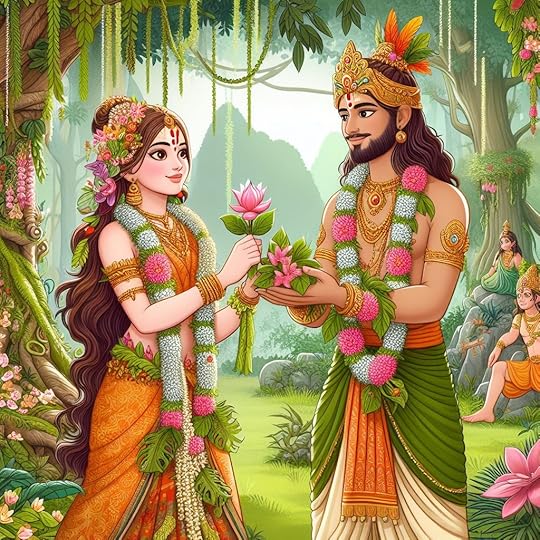 Shakuntala is also Menaka’s daughter but with RishiViswamitra and abandoned at birth in the Himavant valley near Rishi Kanva’sashram. She grew up into a beautiful young woman. One day, when King Dushyantof Hastinapura went hunting in the forest, he came across the ashram and metShakuntala. It was love at first sight, and the couple got married. He left forthe kingdom, after promising to send for her but didn't. When Shakuntala wentby herself with their child, Bharat (first named Sarvadamana), Dushyant deniedknowing her.
Shakuntala is also Menaka’s daughter but with RishiViswamitra and abandoned at birth in the Himavant valley near Rishi Kanva’sashram. She grew up into a beautiful young woman. One day, when King Dushyantof Hastinapura went hunting in the forest, he came across the ashram and metShakuntala. It was love at first sight, and the couple got married. He left forthe kingdom, after promising to send for her but didn't. When Shakuntala wentby herself with their child, Bharat (first named Sarvadamana), Dushyant deniedknowing her. Shakuntala took him to task with her speech. A voicefrom heaven spoke, declaring her truthful. Dushyant apologized to her and saidhe deliberately acted as if he had forgotten her since he wanted everyone toknow the truth from the celestial voices. He said no one would dare to questionher and their child’s parentage now.
Note: Kalidasa’sShakuntala is a dramatized retelling and differs from the Mahabharataversion.
In Aranyaka Parva, we have two more stories –
Nala and Damayanti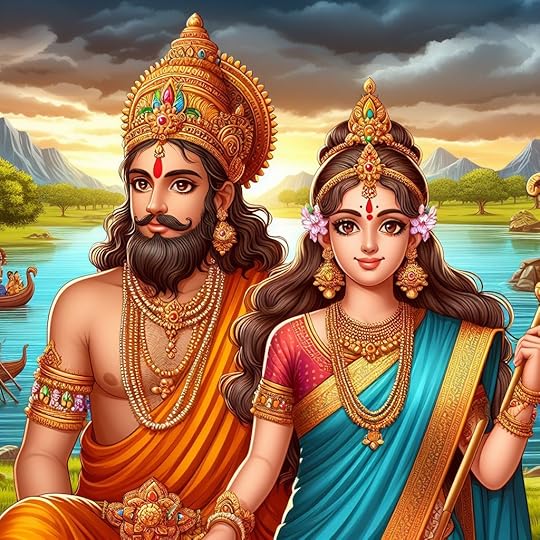 Nala is a Nishada king, and Damayanti is theprincess of Vidharba. The swans share stories and make the couple fall for eachother even though they don’t meet until later. Though Damayanti’s parentscalled the gods for her swayamwar, she chose a human king, which irked Kala/Kali. After many years, Kala managed to enter Nala’s body and made him lose thedice game with his brother. Nala lost everything and left for the forest.Damayanti followed him. Unable to see her plight, Nala left her and wentsearching for work, hoping she would go back to her father’s kingdom.
Nala is a Nishada king, and Damayanti is theprincess of Vidharba. The swans share stories and make the couple fall for eachother even though they don’t meet until later. Though Damayanti’s parentscalled the gods for her swayamwar, she chose a human king, which irked Kala/Kali. After many years, Kala managed to enter Nala’s body and made him lose thedice game with his brother. Nala lost everything and left for the forest.Damayanti followed him. Unable to see her plight, Nala left her and wentsearching for work, hoping she would go back to her father’s kingdom. However, Damayanti went to another kingdom andstayed there as a maid until she was discovered by her father’s ministers. Shewent back to Vidharba and continued to search for Nala. Nala was working as acharioteer in the Samsumara kingdom. He learned the game of dice from the king,and in exchange, taught him everything he knew about horses.
Finally, Nala and Damayanti were united again whenshe cleverly called for a second swayamwara to bring him out of his disguise.Nala played one game with his brother and won back everything. He also forgavehis brother, shared half the kingdom, and lived happily with Damayanti.
(This story has many parallels with what happened tothe Pandavas)
Savitri and SatyavanThe story of how Sati Savitri brought back herhusband alive by following Yamadharmaraja into hell is popular and retoldcountless times over the years. Though the story belongs to Devi BhagavataPurana, it is narrated by Rishi Markandeya to Yudhistira in AranyakaParva.
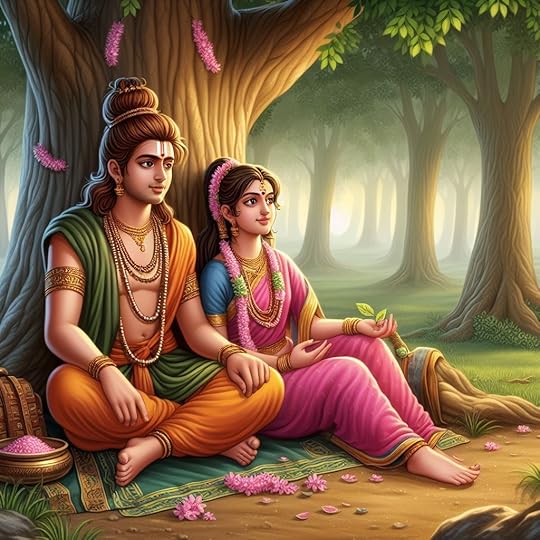 Savitri was the princess of Madra. When she was ofthe marriageable age, many kings were eager to wed her. However, Savitri wantedto marry Satyavan, the son of Dyumatsena. Though Satyavan was a prince, hisfather’s old age and lack of sight resulted in an enemy conquering theirkingdom and exiling the family. They lived in a forest when Savitri came acrossSatyavan and found his devotion to his parents admirable.
Savitri was the princess of Madra. When she was ofthe marriageable age, many kings were eager to wed her. However, Savitri wantedto marry Satyavan, the son of Dyumatsena. Though Satyavan was a prince, hisfather’s old age and lack of sight resulted in an enemy conquering theirkingdom and exiling the family. They lived in a forest when Savitri came acrossSatyavan and found his devotion to his parents admirable. Savitri married Satyavan, knowing he had a shortlifespan and would die a year and a day after the wedding. Very soon, thefateful day arrived. Savitri accompanied him into the forest to chop wood. Shewas with him when he felt faint and passed away. She saw Yamadharmaraja himselfarrive to collect Satyavan’s soul, as her husband was a nobleman with noflaws.
Savitri followed Yamadharmaraja, who told her not todo so. She engaged him in a conversation, discussing the qualities of friends,life partners, dharma, etc. Yamadharmaraja was so impressed by her knowledgeand grace that he gave her a boon after boon, and finally, Savitri managed toget a boon to have many children. When he granted the boon, she pointedout the loophole that she couldn’t have children without her husband and wantedhis life back.
Yamadharmaraja was so impressed by her that herestored Satyavan to life and blessed the couple to lead happy and long lives.By the time they went back home, Savitri’s other boons also began to work. Herfather-in-law’s eyesight was restored. Later, he regained his kingdom. Hisfather had more children to continue his lineage. Savitri and Satyavan also hadkids and lived happily ever after.
I’m participating in #BlogchatterA2Z.
The AI images are made on Bing.
April 11, 2024
K for Kubera’s Sabha - Mahabharata Mashup
Namaste,
Yes, we are having another post on Sabhas (palacecourtrooms). This time, it is Kubera’s Sabha. Kubera is a Yaksha (naturespirit) king and the god of wealth and prosperity. He holds the northernposition and protects the world on that side.

Mahamuni Narada described Kubera’s Sabha as –
It is a hundred yojanas long and seventy yojanasbroad (one yojana is ~8 km). It shines brighter than the moon and MountKaliasa. Supported by the Guhyakas (celestial beings and attends of Kubera), itseems to float in the sky, almost like suspending midair. The Sabha has manygolden palaces and gem-studded walls. A wonderful heavenly scent fills thespace.
Vaisravana-Kubera sits in the center, surrounded byhis thousand wives. The place is filled with luxuries like plush carpets,footstools, decorated chairs, etc. Thousands of Gandharvas (Chitrasena,Tumburu, etc.), Kinnaras (part-human, part-bird celestial beings who lovedmusic and dance), and Apsaras are members of his court and often found singingand dancing to their heart’s content.
 Goddess Lakshmi can also be seen in Kubera’s Sabha.His son, Nalakubera, and thousands of spirits reside there. Many celestialrishis, including Narada, often visit Kubera’s Sabha. In fact, the rakshasachief and other rakshasas and pichasas are also found here.
Goddess Lakshmi can also be seen in Kubera’s Sabha.His son, Nalakubera, and thousands of spirits reside there. Many celestialrishis, including Narada, often visit Kubera’s Sabha. In fact, the rakshasachief and other rakshasas and pichasas are also found here. In short, anything to do with the spirit world canbe seen in Kuebra’s Sabha since he is not only the God of Wealth but is alsothe King of Yakshas. Kubera looks much like the laughing Buddha with a roundedbelly and pots of wealth.
By the way, do you know the story about the creation of the universe? Check it out here!
A Telugu socio-fantasy movie, Maya Bazar (2006), hadSP Balasubramanyam as Kubera. It was probably the only (or one of the very few)films to have Kubera in a prominent role. Here’s a scene from it. (The vehicle Kubera rides is the Pushpaka Viman. In letter R, we'll see how it came to be in Ravana's possession.)
I’m participating in #BlogchatterA2Z.
The AI images are made on Bing.
April 10, 2024
J for Janamejaya’s Snake Sacrifice - Mahabharata Mashup
Namaste,
King Janamejaya is the son of Parikshit, the son ofAbhimanyu and Uttara. He is the great-great-grandson of Arjuna and Krishna andthe ruler of Hastinapura.
We’ll read what happened to King Parikshit in thecoming posts. Here, we’ll read about the snake sacrifice Janamejaya organizedto avenge his father’s death.
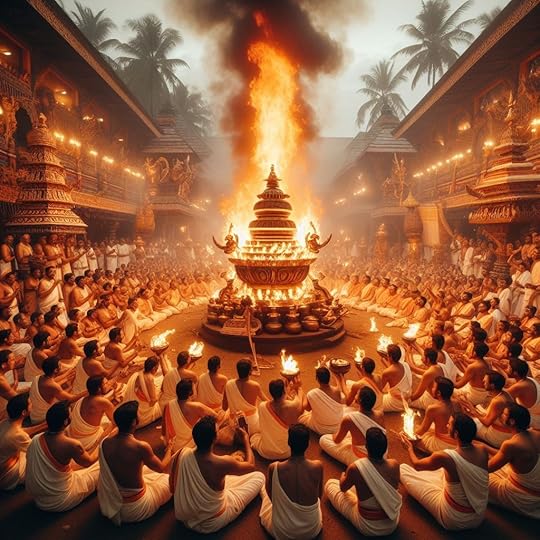
One day, Rishi Uttanka went to King Janamejaya andshared the story of Takshaka, the Naga Raja who was responsible for the deathof the king’s father. After Janamejaya gathered more information, he planned toconduct a large sacrifice to kill Takshaka. Rishi Uttanka wanted this since healso had to face hardships due to Takshaka and wanted revenge.
The preparations of the sacrifice were made.However, even before the event began, one of the builders had a vision and saidthe snake sacrifice would not be completed.
This came true even though Janamejaya ensuredadequate reinforcements to protect the area. Rishi Astika (son of Jarakatu andJarakatu and nephew of Vasuki, a naga) went to the sacrifice and asked for agift. When Janamejaya agreed, Astika asked the king to stop the sacrifice sincemany innocent snakes were also dying. The king gave his word and hence stoppedthe sacrifice.
So, did Takshasa die? No.
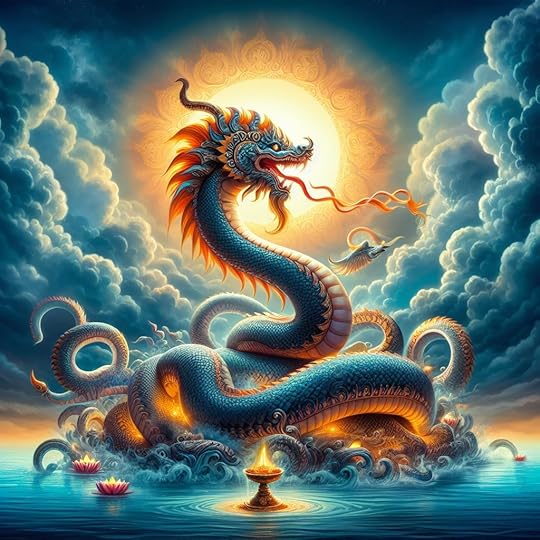
Takshaka learned of the sacrifice and took refuge in Indra’s garden. However, the Hotri chanted mantras that made Takshaka visibleeven though he was trying to hide. By using Taksaka’s name, the Hotri couldbring him closer to the yagna fire. At this moment, Astika insisted the kinggrant him the boon. Janamejaya couldn’t (wouldn't) refuse. Hence, Takshaka’s life wassaved.
King Janamejaya realized it wasn’t his job to killthe Naga and let go of his plan. He then requested Vyasa Mahamuni (one of the esteemedguests at the event) to tell him the entire story of his ancestors. Vyasagestured to his student Vaisampayana, who narrated Mahabharata to theking.
Note: You can find more details of this episodein Astika Upa Parva of Adi Parva.
I’m participating in #BlogchatterA2Z.
The AI images are made on Bing.
Death in the Details by Katie Tietjen - Book Review
Series: #1 (couldn’t find the series title)
Publication Date: 09th April 2024
Genre: Historical Cozy Mystery
3.5 Stars
One Liner: A decent start to a series
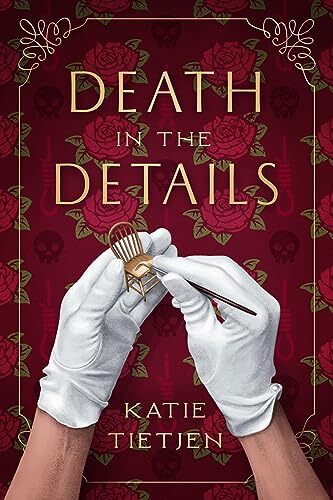
1946, Vermont
Maple Bishop is stunned to discover that her doctor husband, Bill, left her almost penniless after his death. WWII has taken a lot from her, and she could lose even her home if she didn’t find a way to earn money.
Creating miniature houses (dollhouses) has been her passion (obsession) for a long time. Maple realizes she could turn it into a source of income. After all, no one wants to hire a woman despite her lawyer degree. Things take another turn when Maple’s first customer is found dead. The police call it suicide, but she cannot ignore the feeling that something is not right.
As Maple recreates the crime scene, in the nutshell, she decides to investigate the case and find out more. Can Maple succeed?
The story comes in Maple’s third-person POV.
My Thoughts:This is a debut book and the first in the series (I couldn’t find the series title anywhere) inspired by the real life of Frances Lee Glessner, the woman famous for replicating miniature crime scenes with exact details.
I googled Frances before starting the book and realized there are many books available about the cases she solved. The book is only inspired by Frances, so Maple’s character stands on her own, has a backstory, and everything.
The blurb reveals a bit too much. One part of it doesn’t occur until 50%, so editing out the last paragraph to remove these details might be better.
The book is less than 300 pages and has a decent pace. It starts slowly (not surprising) but gains momentum as we settle into the narrative. There are enough scenes about dollhouse-making for the page count. I don’t need an introduction manual anyway.
Maple is a complex character. She is socially inept and brisk. She has many unresolved traumas and holds on to the past very tightly. She is also judgmental and not easy to like. Yet, I found that the character arc was decent (if not relatable). She realizes a few things and tries to take corrective steps. So, the way she handles the clues and solves the crime in a way aligns with this arc. (This may not work for everyone as it affects the mystery)
Apart from the mystery, the book focuses on personal tragedies, trauma, grief, PTSD, domestic abuse, etc. The beginning section, especially reads more like historical fiction. The mystery enters afterward.
The book has a neatly tied-up ending with a detailed epilogue of sorts. It can be a series (as mentioned in the blurb) or limited as a standalone.
To summarize, Death in the Details is an interesting read, even if it didn’t wow me. I would be willing to read the next book in the series.
Thank you, NetGalley and Crooked Lane Press, for eARC.
#NetGalley #DeathInTheDetails
April 9, 2024
I for Indra’s Sabha - Mahabharata Mashup
Namaste,
As I mentioned in Day 2’s post (Brahma's Sabha),Mahamuni Narada described many celestial courtrooms (Sabha). Now, let’s see howhe described Indra’s Sabha. Indra is the King of Heaven.
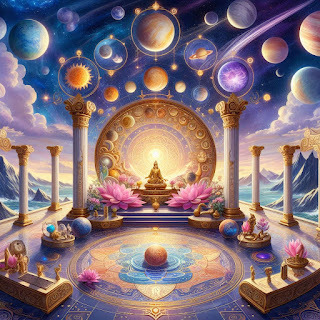
Dimensions: (One yojana is ~8 kilometers)
Length: one hundred and fifty yojanas Breadth: one hundred yojanas Height: five yojanasThe Sabha moves of its own will and has a soothingvibe. It removes pain, anguish, grief, decay, etc., and contains countlessrooms with as many seats as required.
Indra would sit on the throne with Sachi, his wife.He has a crown and bright bracelets on his arms. He wears a pure white dressand multicolored garlands. Fame, Glory, and Loveliness are found at his side.
Maruts, Siddhas, Sadhyas, celestial rishis, etc.,are members of his court and often perform glorious yagnas. The Gandharvas,Yakshas, apsarasas, Viswakarmanm, and many other rishis (some of them arekings-turned-rishis) can be found in the Sabha. Famous kings and warriors whohave passed away can also be seen attending Indra’s Sabha.Note: In Adi Parva, we see a detailed list of various celestial beings who took birth on the earth as humans during the Dwapara Yuga.
 The purshartas (Dharma, Artha, Kama), traits likefaith, learning, intelligence, and valor, elements like lightning, rain, winds,and clouds, etc., are also found in this Sabha. Similarly, the stars, the sun,the moon, the planets (especially Brihaspati aka Jupiter and Sukra aka Venus),twenty-seven flames of Agni (fire), rishi Bhrugu and the sapta rishis (sevenfamous rishis) are also members of Indra’s Sabha. Dead noblemen with childrenwho performed the last rites and rituals correctly are also said to gainentrance to this Sabha.
The purshartas (Dharma, Artha, Kama), traits likefaith, learning, intelligence, and valor, elements like lightning, rain, winds,and clouds, etc., are also found in this Sabha. Similarly, the stars, the sun,the moon, the planets (especially Brihaspati aka Jupiter and Sukra aka Venus),twenty-seven flames of Agni (fire), rishi Bhrugu and the sapta rishis (sevenfamous rishis) are also members of Indra’s Sabha. Dead noblemen with childrenwho performed the last rites and rituals correctly are also said to gainentrance to this Sabha.
The Sabha is also called the Hall of LotusGarlands.
Indra is also one of the Ashta Dikpalakas (Guardians of Directions) and guards the East side. The others are -
Kubera on the North Varuna on the West Yama on the South Agni on the Southeast (Agneyam - where the kitchen is built)Isana on the Northeast (Eisanyam)Vayu on the Northwest (Vayuvyam)Nirriti on the Southwest (Niaruti) You'll notice how the names align with the terms used in Vastu Sastra and weather reporting.Fun Fact: Doyou know Indra is not a name but a title? Many gods have taken the position ofIndra over the Yugas. I found out when reading Devifor Millennials by Bibek Debroy.
I’m participating in #BlogchatterA2Z.
The AI images are made on Bing.
April 8, 2024
H for Hidimba’s Son, Ghatotkacha - Mahabharata Mashup
Namaste,
This is a roundabout post since I already used G formy favorite scene. Anyway, we can talk about two characters from Mahabharathain the same post, so that’s a plus.
Hidimba is a rakshasi (demoness) and the twin sisterof Hidimba, a male demon. They first appear in Adi Parva when the Pandavasescape the burning of the House of Lac and pause to rest in a forest.Hidimba sent his sister to find out who the humans were with a plan to consumethem as a meal. However, when the rakshasi saw Bhima, she fell in love with hisphysique and his devotion to his mother and brothers.
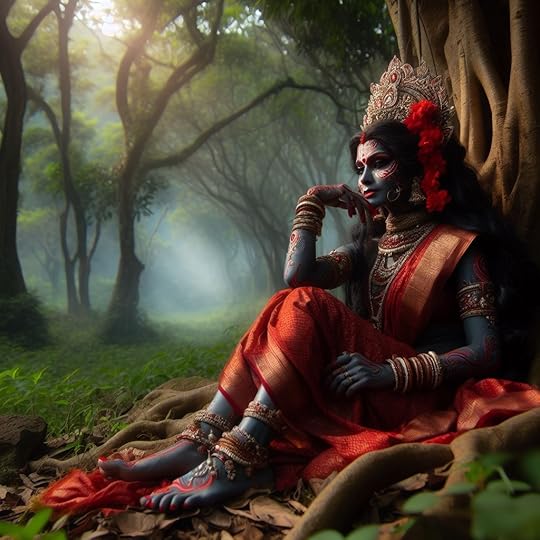 She transformed into a beautiful woman to talk toBhima. Her brother didn’t like this and attacked Bhima, who killed him. Hidimbaproposed marriage, but Bhima declined. Then, she convinced Kunti, saying shewasn’t a Yatudhani (evil spirit) but a Salakatarikati (another type ofrakshasa). She had a gift of sight and guided them to a safe place, sayingVyasa would meet them soon. Kunti agreed to have Hidimba as her daughter-in-lawbut said Bhima would not stay with her in the forest forever.
She transformed into a beautiful woman to talk toBhima. Her brother didn’t like this and attacked Bhima, who killed him. Hidimbaproposed marriage, but Bhima declined. Then, she convinced Kunti, saying shewasn’t a Yatudhani (evil spirit) but a Salakatarikati (another type ofrakshasa). She had a gift of sight and guided them to a safe place, sayingVyasa would meet them soon. Kunti agreed to have Hidimba as her daughter-in-lawbut said Bhima would not stay with her in the forest forever. Hidimba agreed and said she would willingly let himgo once she had a child. Thus, during their stay, Hidimba and Bhima spent time together in the morning while Bhima returned to guard his family at night.
Soon, Bhima and Hidimba had a son, a half-rakshasa,whom they named Ghatotkacha. He was named thus since his head resembled a waterpot (Ghata). He loved the Pandavas, and they loved him. After he grew up alittle, the Pandavas left the forest while Hidimba and Ghatotkacha stayed backin their domain.
Fun fact: Doyou know there’s a HidimbaDevi temple in Manali? It is locally called the Dhungari Templeand was built in the Dhungiri Van Vihar by Maharaja Bahadur Singh in1553.
Over the years, Ghatotkacha helped the Pandavas manytimes. He was loving, respectful, and devoted to them.
InSabha Parva, Sahadeva asked Ghatotkacha to fly to Lanka and inform Vibhishan (the king of Lanka) about Yudhistira’s Rajasuya and bring gifts.In Aranyaka Parva, Yudhistira calledGhatotkacha to help them during the pilgrimage and carry Draupadi when climbingMount Kailasa to reach Gandhamadana. Ghatotkacha and a team of rakshasas stayed withthem for many years. He helped them go down the Kubera Mountain to spendthe last phase of their exile.
Ghatotkachahad a prominent role in the Bhishma and Drona Parvas and killed many warriors on the Kaurava side, including another rakshasa Alambusa. When Karna killedGhatotkacha, he managed to squash one akshauhini of the Kaurava army under hisbody before breathed his last.
(One Akshauhini = 21,870 chariots; 21,870elephants; 65,610 horses and 109,350 foot soldiers)
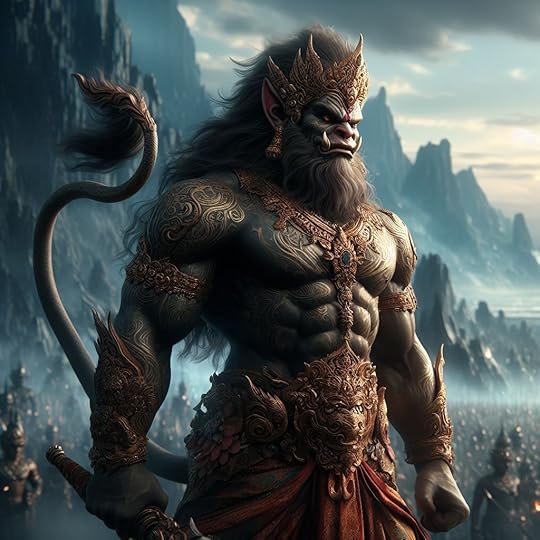
Yudhistira had a special love for Ghatotkacha andwas devastated by his death in the Kurukshetra War (killed by Karna).
(Baby) Ghatotkacha was described thus by Vyasa – "afierce-eyed, large-mouthed baby with ears like arrows and a fear-instillingface, a roaring voice, brown lips, and sharp teeth. He was powerful andathletic, like a chariot hero. He had a long nose, a broad, swelling chest,calves rippling with muscles, and amazing swiftness of speed. He was hardlyever a boy; he looked so full-grown, and very soon, he became renowned as anexpert arms-wielder."
For me, Ghatotkacha has always been – SV Ranga RaoGaru from Mayabazar (1957).
This is the Technicolor version.
I’m participating in #BlogchatterA2Z.
The AI images are made on Bing.
The Heart of Winter by Shona Kinsella - Book Review
Publication Date: 16th April 2024
Genre: Historical Fantasy
3.5 Stars (rounding up coz Cailleach gets the respect she deserves)
One Liner: Great start but almost negates its own premise
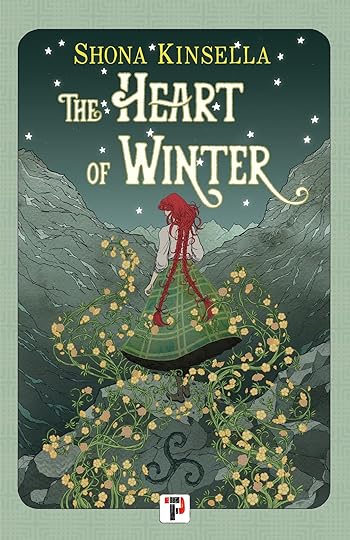
Young Brigit may be a crofter’s daughter but loves her life with her parents and her independence. When she is forced to marry Aengus, the God of Summer, to keep a bargain, she flees the village. Brigit has always loved and worshipped Cailleach, the God of Winter. Who else but Cailleach, the god who needs no man, can save Brigit?
However, Brigit soon realizes her journey is not easy. She will have to push beyond her limits repeatedly to get what she wants – freedom but also the safety of her village. Can Brigit be successful? What will it cost her?
The story comes in the third-person POV of Brigit (more), Cailleach, and Aengus.
My Thoughts:I requested this book for Brigit (the spelling). Of course, I was curious to see where the plot would lead.
The book has a solid start despite the clear modern influence on the FMC. I quite enjoyed the dynamics and her relationship with her parents. They were wonderful!
The next was good, too, as Brigit goes on a quest to get what she wants, or rather avoid something she doesn’t want! There’s enough repetition for us to understand that her objection lies with how they didn’t ask for her consent before making a promise on her behalf.
Cailleach was terrific. And I love that she is not the demonized version of the Winter Goddess but a softer and more sensible version. After all, winter is just as important for the world as summer and monsoon.
The pacing is on the slower side, even though it feels like not much has happened. This could be due to the repetition. Moreover, the cozy vibes take the edge off the urgency of the situation.
I love the two wolves! They are the best part of the story.
Of course, I admire how the old gods are shown in a positive light (Aengus did get some hard times, which seems unfair once you see what happens afterward). It’s a relief from having to read about angry and vengeful pagan gods (one reason why I stay away from all those retellings and YA fantasy).
I also like the bit of foreshadowing, which connects to a later development. The clue is in the name. While adults were the ones guiding the girl, I didn’t find it odd. They are more experienced. It makes sense that they take the role of mentors.
What I didn’t like much was how a development negated the premise. I think it could have been better handled. Because if this happened at the beginning, the book wouldn’t have a chance to exist. I understand the need to change power dynamics, which is why I wanted this development to be independent of the core premise (this is how it reads when you don’t want to reveal spoilers).
There’s no denying the potential of the premise. It just needs better structuring to ensure the elements included stay valid throughout. Still, I appreciate the respect given to the old gods. I also hope the final and published copy has the author’s note. This book needs one. Add it!
To summarize, The Heart of Winter is a heartwarming story of Brigit and her connection with the Celtic gods. While it is not fantastic, it made me smile many times.
The title works on multiple levels. Good job, whoever came up with it!
Thank you, Book Sirens and Flame Tree Press, for eARC. This review is voluntary and contains my honest opinion about the book.
***
TW: Miscarriage
***
Here's a short story I wrote about Brigit for a writing challenge.



